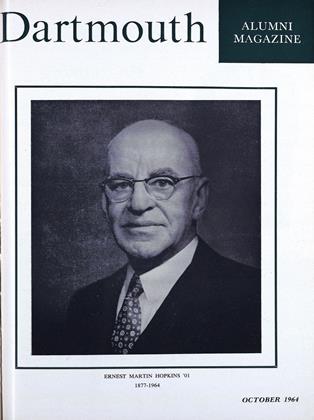By David F.Long '39. Skokie, Ill.: Rand McNally &Co., 1964. 464 pp. $6.95.
This is a relatively brief but inclusive illustrated history of the United States in its relations with foreign powers in the years between the American Revolution and the present, with more than half the volume dealing with the period since 1900. It is not the first work in the field of U. S. foreign relations which includes pictures and drawings, but it is unique in its emphasis upon fully contemporary illustrations, and especially upon cartoons which are correlated with the text and aid greatly the reader's understanding of the moods and prejudices of the time.
Professor Long conceived the idea in connection with a TV course in American history and the result is a volume with scarcely a page without some picture, cartoon, or map. To accumulate his illustrative material Dr. Long made extensive use of many periodicals with Punch and Harpers well to the front and located in a number of different depositories with the New York Public Library and the Library of Congress well in the lead.
Though relatively moderate and conventional in its approach to the diplomatic story the book is lively and readable. Dr. Long has an eye for colorful quotes which help greatly to bring the actors to life. We remember the exploits of William Walker "The five-foot, five inch, self-appointed Man of Destiny" and Henry Adams confessing "I turn green in bed at midnight if I think ... we must slaughter a million or two foolish Malays in order to give them flannel petticoats and electric railways."
There is naturally much of relations with Latin America and we hear T.R. swearing that one could no more make a lasting agreement with Colombia "than you could nail current jelly to the wall." We hear one critic concluding that in Nicaragua idealist Wilson made Taft's Dollar Diplomacy "look like the proverbial 30 cents" and see Clemenceau sneering at Wilson's Fourteen Points when "God Almighty had only ten."
Changing interpretations are explained and an honest frankness pervades the book. There is a helpful index but no bibliography.
Professor of History Emeritus
 View Full Issue
View Full Issue
More From This Issue
-
 Feature
FeatureThe Hopkins Administration Steps Forward as a National
October 1964 -
 Feature
FeatureSome Hopkins Views on Higher Education
October 1964 -
 Feature
FeatureA.B.C. Project and Students Both Measure Up to High Expectations
October 1964 -
 Feature
FeatureThe End of a Dartmouth Era
October 1964 -
 Feature
Feature"This Considerate, Friendly Personality"
October 1964 -
 Article
ArticleTHE FACULTY
October 1964 By GEORGE O'CONNELL
ALLEN R. FOLEY '20
-
 Books
BooksMR. MADISON'S WAR
January 1937 By Allen R. Foley '20 -
 Books
BooksTHE LUSTY TEXANS OF DALLAS
March 1951 By ALLEN R. FOLEY '20 -
 Books
BooksSINCE 1900 (Rev. Ed.)
October 1952 By Allen R. Foley '20 -
 Article
ArticleTHE HANOVER POST OFFICE
JANUARY 1963 By ALLEN R. FOLEY '20 -
 Article
ArticleHANOVER DOGS 1963
MAY 1963 By ALLEN R. FOLEY '20 -
 Article
ArticlePOPULATION AND POLITICS
MARCH 1964 By ALLEN R. FOLEY '20
Books
-
 Books
BooksSABOTAGE! THE SECRET WAR AGAINST
November 1942 By Herbert f. West '22. -
 Books
BooksTHE CALIFORNIA 2000 CAMPAIGN: THE POPULIST MOVEMENT WITH A MEANING FOR ALL AMERICA.
October 1974 By JAMES C. WICKER '21 -
 Books
BooksMARKETING MANAGEMENT.
January 1962 By Louis P. BUCKLIN '50 -
 Books
BooksTurning Pro: Undergraduate writers break into print
OCTOBER 1981 By Robert H. Ross '38 -
 Books
BooksSELECTED LETTERS OF WILLIAM ALLEN WHITE.
March 1947 By Robert Lincoln O'Brien '91 -
 Books
BooksGREAT PRAISES.
November 1957 By THOMAS H. VANCE


